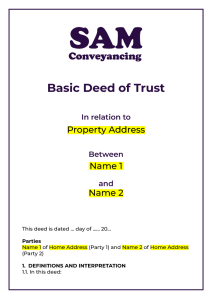Beneficial Ownership vs Legal Ownership
Legal ownership refers to who is named on the title deeds, while beneficial ownership refers to who actually benefits financially from the property.
For the majority of jointly owned properties, legal and beneficial owners are the same. However, you can be a beneficial owner but not a legal owner. For example:
- A husband owns a buy-to-let but has assigned the beneficial interest to his wife for tax purposes using a Deed of Assignment.
- An unmarried couple own a property together and pays for all the property costs jointly, however, the property is only registered in one of their names.
What share in the property does a legal owner have?
Legal ownership of a property is determined by who is named on the title deeds registered at the Land Registry. Unlike beneficial ownership, which can be divided into specific percentage shares, legal ownership is not expressed as a percentage. Up to four individuals can be named as legal owners on the title.
If two or more people are legal owners, they jointly own the entire property. This means that each legal owner has equal rights to possess and use the whole property, but doesn't automatically mean they each own 50% (or any other specific percentage) of the beneficial interest. Their beneficial interest could be split 60:40 or even 90:10.
The beneficial interest can be divided between the legal owners (or other parties) in any proportion, as documented in a separate agreement (like a Deed of Trust).
For example, imagine two people, Annie and Bill, are legal owners of a property. They both have the right to live in the property and make decisions about it.
However, their agreement might stipulate that Annie has a 70% beneficial interest and Bill has a 30% beneficial interest. This means that if they sell the property, Annie would receive 70% of the proceeds (after any mortgage is paid off) and Bill would receive 30%, regardless of their equal legal ownership.
Book a FREE 15-minute meeting* with a specialist property dispute solicitor/consultant.
They'll listen to your issue and suggest ways forward, including the costs, with no obligation to use our services after the free meeting.
- Can my partner sell the house?
- What are my rights to stay?
- Am I due a share?
- Can I get my name on the legal title?
- Can I stop paying the mortgage if I move out?
The difference between a legal owner and a beneficial owner
Legal Ownership: The essentials
The legal owner of a property is always registered at the Land Registry and their name is on the title deeds.
- Legal owners are always named on the title deeds.
- A maximum of four individuals can be legal owners.
- Legal owners have the right to possess, use, and transfer the property.
- They are responsible for legal and administrative matters, including taxes and maintenance.
- Legal owners are typically responsible for mortgage repayments.
- Legal ownership doesn't automatically mean beneficial ownership.
Beneficial Ownership: The essentials
A beneficial owner is someone, or an entity, that ultimately benefits financially from a property.
- Beneficial owners ultimately benefit financially from the property.
- Their names are not necessarily on the title deeds.
- There can be multiple beneficial owners with varying shares.
- Beneficial ownership can be held by individuals, companies, or trusts.
- Beneficial owners have the right to use and enjoy the property, receive income, and profit from its sale, according to their share.
- Beneficial interests are often documented in a Deed of Trust.
- Beneficial interests are subject to lender rights if there's a mortgage.
How to prove beneficial interest in property
Without proper documentation, disputes can arise, and it can be difficult to prove your share of the property's value. To evidence you have beneficial ownership of property, you can provide:
A Deed of Trust
A Deed of Trust is the most common way to formally declare the beneficial ownership of a property and protect your investment. It's a legal document that clearly sets out the ownership percentages of each beneficial owner, how the property's proceeds should be divided upon sale, and any other relevant agreements. It's highly recommended to have a Deed of Trust drawn up by a solicitor when purchasing a property with shared beneficial ownership.
A Deed of Assignment
A Deed of Assignment is used to transfer an existing beneficial interest from one person to another. For example, if someone wants to gift or sell their share of the beneficial ownership, a Deed of Assignment would be used.
TR1 Form (Transfer Deed)
While the TR1 form primarily deals with the legal transfer of property, it can also be used to declare beneficial interests. However, a separate Deed of Trust is generally considered a more comprehensive and advisable way to document beneficial ownership.
A Written Agreement
A written agreement outlining the beneficial ownership can be helpful, but it's not as legally robust as a Deed of Trust. It's always best to formalise the agreement with a solicitor-drafted Deed of Trust to avoid any potential disputes down the line.
Other Evidence
Evidence of your financial contributions towards the property (e.g., bank statements showing deposit payments, mortgage contributions, or renovation costs) can help support your claim to beneficial ownership, especially if there's no formal agreement in place. However, this evidence alone is not always sufficient, and a formal legal document is always preferable.
Protect your interest in a property and confirm how to sell. Drafted by a solicitor.
The first draft is within 1 to 2 working days* and includes:
- Deposit paid.
- The percentage ownership of each party.
- How to share expenses like the mortgage and bills.
- Share of property income - rent or gain on sale.
- How to sell the property.
- How the property is divided in the event of separation, divorce, or death.
Joint Tenants or Tenants in Common - the impact on beneficial and legal interests
When two or more people own a property together, they do so as either Tenants in Common (separate shares) or as Joint Tenants (owned 100% between a maximum of 4 legal owners - normally married couples or civil partners).
Joint Tenants
When legal owners hold a property as joint tenants, they also typically hold the beneficial interest jointly. This means that each owner has an equal and undivided share of the entire beneficial interest. Any gain or loss from the property is 100% theirs jointly and shared 50/50 on their tax return.
Crucially, joint tenancy includes the "right of survivorship." If one joint tenant dies, their share of the beneficial interest automatically passes to the surviving joint tenant(s).
It doesn't matter what their will says; the property automatically goes to the other owner(s). This is common for married couples or civil partners where they want the surviving spouse to inherit the property.
Tenants in Common
When legal owners hold a property as tenants in common, they can own separate and distinct shares of the beneficial interest. These shares can be equal or unequal, meaning they can declare a separate beneficial interest that might reflect each person's contribution towards the property.
This is normally shown as a direct percentage of the amount of money paid towards the purchase deposit (purchase price less the mortgage), however, it could take into account other contributions towards the property such as mortgage repayments and renovation work.
Unlike joint tenancy, there is no right of survivorship. If a tenant in common dies, their share of the beneficial interest passes according to their will (or the rules of intestacy if they don't have a will).
They can leave their share to anyone they choose. This is often used when co-owners are not married or when they want to own different proportions of the property.
Beneficial and legal ownership: A practical example
Imagine Jane and Tom, who are not married, want to buy a home together for £250,000. Tom is contributing £100,000 towards the purchase price, but he doesn't want to be a legal owner.
Here's how their ownership could be structured:
- Legal Ownership: Jane is the sole legal owner. Only her name is registered on the title deeds at the Land Registry. She is legally responsible for the property.
- Beneficial Ownership: Jane and Tom agree to own the property as tenants in common, reflecting their financial contributions. Jane owns 60% of the beneficial interest (£150,000 / £250,000), and Tom owns 40% (£100,000 / £250,000). This agreement is documented in a Deed of Trust, clearly outlining their respective shares.
What happens if they sell? If, in a few years, Jane and Tom sell their property for £300,000, the proceeds will be distributed according to their beneficial interests as outlined in the Deed of Trust. Jane will receive 60% (£180,000), and Tom will receive 40% (£120,000), although Jane was the sole legal owner.
Mortgage Considerations: If Jane and Tom were getting a mortgage, they would need the mortgage lender's consent to the Deed of Trust. Lenders want to be sure that they can recover their loan if needed, so they'll typically want all legal owners to be responsible for the mortgage.
Some lenders offer specialised mortgages, such as Joint Borrower Sole Proprietor mortgages, that are designed for situations where one party wants to contribute financially but not be a legal owner.
Tax implications for beneficial and legal ownership
Capital Gains Tax (CGT)
When a property is sold, Capital Gains Tax (CGT) may be payable on any profit (gain) made. However, the key point is that CGT is levied on the beneficial owners, not necessarily the legal owners.
The gain is divided proportionally to each beneficial owner's share, as documented in the Deed of Trust or other relevant agreement. So, even if someone is the sole legal owner, they will only be taxed on the portion of the gain that corresponds to their beneficial interest.
This, again, highlights the importance of clearly defined beneficial ownership shares from the outset in a property transaction.
Income Tax
Similarly, rental income generated by a property is taxed according to the beneficial ownership shares, not the legal ownership. Each beneficial owner is responsible for declaring their portion of the rental income on their tax return. This ensures that taxes are paid by those who actually benefit financially from the property, regardless of who is named on the title deeds.
Form 17 and HMRC Compliance
To ensure clarity and avoid disputes with HMRC, especially when beneficial and legal ownership differs, you need to submit Form 17 . This formally declares the beneficial interests and how income and gains should be divided.
This is particularly important in situations like the example of Jane and Tom, where Jane is the legal owner, but both share the beneficial interest. Form 17 helps to avoid any confusion about who is liable for which portion of the taxes.

Call us at 0333 344 3234 or request a callback/email to answer your queries about our Land Registry application services. SAM's UK-based team will explain which of our solicitor services are required to make changes to the title.
There's no obligation to instruct. We'll make sure you understand your options and provide a free, fixed-fee quote for our best-value service to meet your needs. No robots, no call centres. Property challenges solved.
Andrew started his career in 2000 working within conveyancing solicitor firms and grew hands-on knowledge of a wide variety of conveyancing challenges and solutions. After helping in excess of 50,000 clients in his career, he uses all this experience within his article writing for SAM, mainstream media and his self published book How to Buy a House Without Killing Anyone.
Caragh is an excellent writer and copy editor of books, news articles and editorials. She has written extensively for SAM for a variety of conveyancing, survey, property law and mortgage-related articles.











